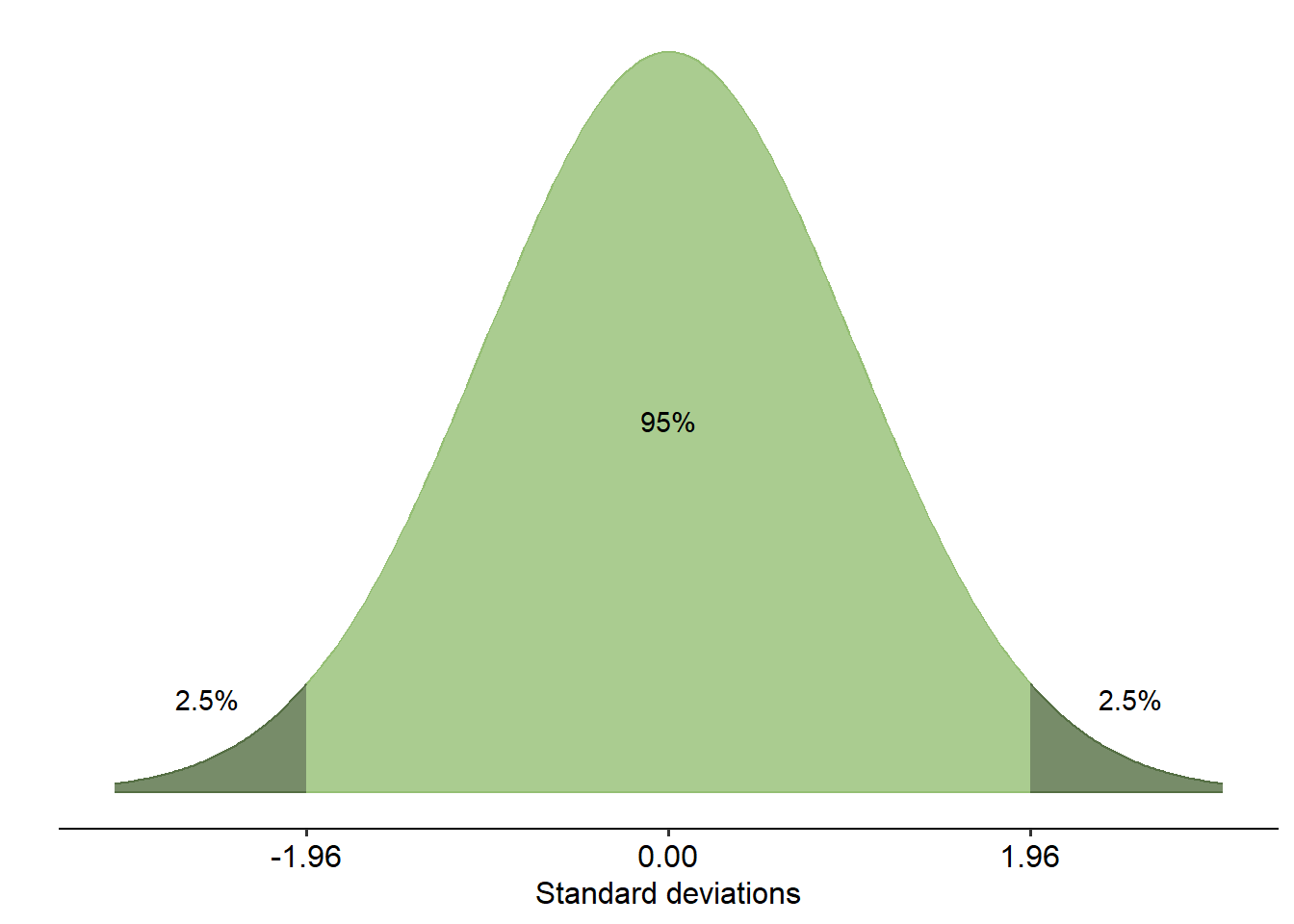4.2 p-values
At one point, the video on the previous page talks about ‘levels of significance’ - what does this actually mean? Here, we’ll talk about the p-value - one of the most commonly used, and possibly abused, concepts in research and statistics. We’ll talk about what the p-value actually means, and tie it to two related concepts later in this module: error and statistical power.
4.2.1 The definition of the p-value
The definition of the p-value is the following (APA Dictionary, 2018):
“in statistical significance testing, the likelihood that the observed result would have been obtained if the null hypothesis of no real effect were true.”
What does this actually mean? We actually already touched on this in the previous page, but let’s dig a bit deeper.
4.2.2 A brief probability primer, and how this relates to p-values
To start with, a p-value is a probability. A probability, of course, ranges from 0 to 1; 0 (0%) representing an impossible result, and 1 (100%) representing a certain result. Probabilities can be conditional, meaning that they are dependent on a certain condition being true. A p-value is a conditional probability. Specifically, a p-value refers to the probability of getting a particular result, assuming the null hypothesis. To illustrate what we mean, consider the two graphs below, showing some example data as points.
On the right is an example of what one possible alternative hypothesis might look like - that this data is meaningfully represented by two underlying distributions or groups, and that there is a difference between these two groups (shown as the blue and red curves). Contrast that with the left graph, where we hypothesise that there is no difference - in other words, that the data can be captured by the one distribution. This graph on the left is a representation of our null hypothesis, and as per the definition of the p-value, this is the distribution we focus on.
The area shaded blue represents the probability of getting that specific result. In the left example, the area shaded represents the probability of getting a value lower than x = 1. You can see that the blue area is quite big, so the probability of getting a value lower than 1 is quite high. On the right hand side is another example, which represents the probability of getting a value of x higher than 2. Here, the shaded area is small, so the associated probability is low.
Now, recall the following figure from last week:

We established last week that on a normal distribution, 95% of the data lies within a certain range of values. Obtaining values beyond these thresholds (1.96 standard deviations either side of the mean) account for a relatively small percentage of possible values. In other words, the probability of getting a value beyond these bounds (in the figure above, where the dark green areas are) is low.
This is basically the thinking we use when we calculate a p-value. Let’s break down the steps:
- We first assume the null hypothesis is true, and so we use the distribution of the null hypothesis to calculate the probability of getting our result or greater.
- To figure out where our result(s) sits on this null distribution, we calculate a test statistic. This test statistic is essentially a value that represents where our data sits on the test (null) distribution. Each test statistic is calculated in a different way because every distribution looks different, so we’ll come back to this over the next couple of weeks.
- Afterwards, we calculate the probability of getting our test statistic (or greater) using a similar logic to the example above. This probability is our p-value. This marks the probability of observing this result or greater.
- Once we have a p-value we then compare this against alpha, which is our chosen significance level (usually p = .05). If the probability of getting our result is smaller than this (pre-defined) cutoff, it means that it is unlikely assuming the null hypothesis is true, and therefore our result is statistically significant and we reject the null hypothesis.
So in essence, if a p-value is p = .05 we’re saying that assuming the null is true, there is a 5% chance of observing this result or greater. Likewise, an extremely small p-value (e.g. p = .0000000001) means that assuming the null is true, the probability of getting the data we have is extremely small. The logic, therefore, is that there must be an alternative explanation.
To clarify, the example above is just on a normal distribution - each statistical test we perform has its own (null) distribution, which we will talk about more in future modules. However, the rationale across tests is essentially the same.
4.2.3 The debate around p-values
Throughout history, p-values have been so misunderstood and misappropriated that some journals, such as Basic and Applied Social Psychology, actually either discourage or outright ban the reporting of p-values. This ties into a wider debate about the usefulness or meaningfulness of the hypothesis testing approach outlined on the previous page, with a number of academics and scientists arguing that it is time to do away with the system as a whole.
The debate is something that goes beyond the scope of the subject, so we won’t be taking a strong stand on it either way. What we do think though is that it’s really important that you understand how hypothesis testing works and what p-values can or can’t tell you.